Mar 26, 2020
Projecting Blue Jays' opening day roster...in 2022
The Toronto Blue Jays rebuild is expected to see the team begin to contend in 2022. With that in mind, TSN’s Scott Mitchell takes a look at what the team’s roster could look like in two years’ time.
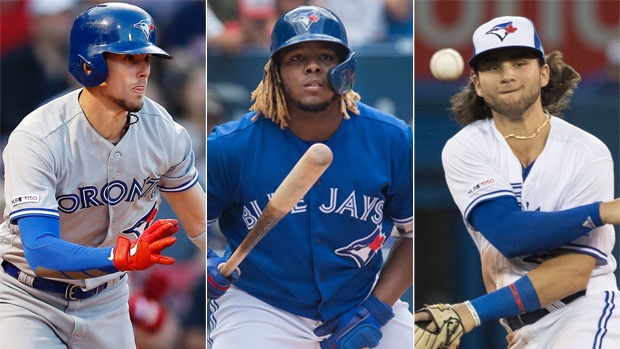
TORONTO — It’s opening day.
Not today, but Thursday, March 31, 2022.
COVID-19 has taught us some valuable lessons but it’s a thing of the past, while the Los Angeles Dodgers are basking in the glow of back-to-back World Series titles.
Karma and Cody Bellinger led them there.
The Toronto Blue Jays’ rebuild has seen steady upward growth, from 67 wins in 2019 to a .475 winning percentage in the shortened 2020 season to finally creeping above the .500 mark at 83-79 in 2021.
The expectations for 2022 are through the roof as the Jays made big free agent splashes three winters in a row in an attempt to augment their young, inexpensive core and join the league’s elite.
That’s the plan.
That’s the hope.
And that’s what Jays GM Ross Atkins believes the future holds.
Today, however, all we can do is dream.
Baseball will not be played on what was originally scheduled to be opening day, and the Boston Red Sox are not in town for a 3:37 p.m. ET first pitch.
Instead, we’ll gaze longingly into the crystal ball.
Just like we did two years ago in trying to predict the 2020 roster, here’s how things could change, or not change, in two years.
CATCHER
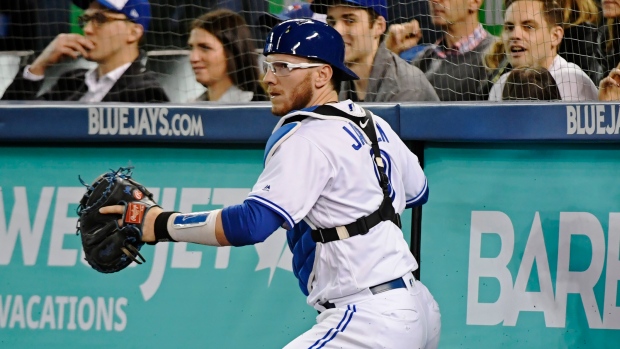
Now: Danny Jansen/Reese McGuire
2022: Danny Jansen
This is an area of impressive depth in the Jays’ organization, which means the position two years from now could look any number of ways based on prospect development, the trade value of the current major-league catching duo, as well as potential changes like robot umpires de-emphasizing framing and altering the skillsets front offices look for.
At this point, Jansen has a chance to stake claim to the position, but to do that the bat will have to come around in a big way after a muted .207/.279/.360 slash line in his first full big-league season in 2019.
Jansen and McGuire would both be hurt by robo umps, as they are lauded for their pitch-framing acumen, a skill that would be rendered almost useless with an automated strike zone.
Behind Jansen, Riley Adams, Alejandro Kirk, a player you’ll read about more shortly, and Gabriel Moreno will all jostle for an opportunity.
Moreno could be the best of the bunch, but a 2022 arrival date might be a bit aggressive with how long it usually takes catchers to develop.
FIRST BASE
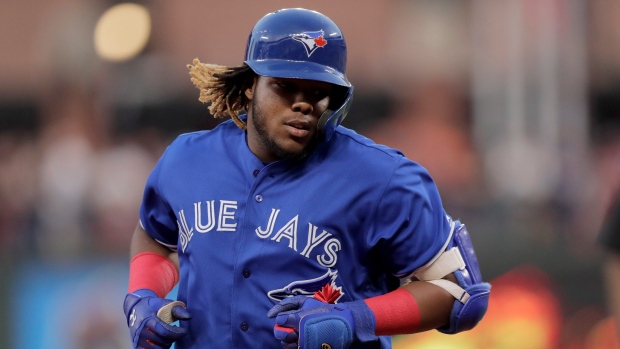
Now: Travis Shaw
2022: Vladimir Guerrero Jr.
Signed to a one-year deal, Shaw is a buy-low placeholder.
Most assume he’s keeping the first base position warm from Guerrero Jr., who will get the 2020 season — if there is one — to prove he can stick at the hot corner for a little while longer.
Acceptable, slightly below average defence is the eventual goal with Vladdy Jr., but his progress at the position is only one part of the equation.
Eventually, other third base options are going to emerge, and the Jays will decide the best defensive configuration is one with Guerrero manning first and worrying more about his 650 plate appearances than his glove.
With good footwork for a big guy and soft hands, Guerrero could eventually turn into a ball-scooping asset at that spot, too.
SECOND BASE
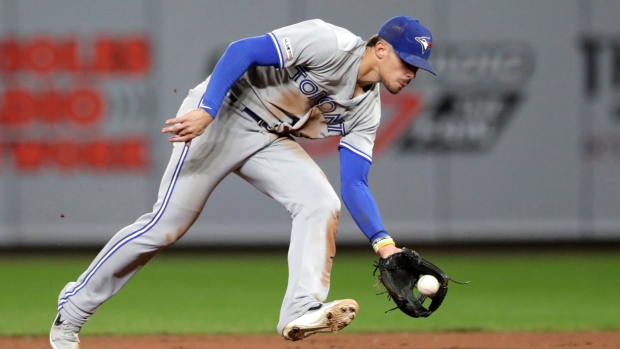
Now: Cavan Biggio
2022: Cavan Biggio
Biggio’s versatility makes him one of the more interesting names to fit in a couple years down the road.
The Jays have been very pleased with his defensive development at the keystone, but they’ve also given him big-league reps in the outfield corners and at first base.
This spring, they’ve also investigated how the soon-to-be 25-year-old would look in centre field.
A Ben Zobrist-type career has long been the thought process, so while he’s installed as the 2022 second baseman here, expect to see Biggio continue to be used in the valuable Swiss Army knife role that’s become so popular over the last few years.
One way that could change would be the quick development of a player like Orelvis Martinez or Miguel Hiraldo, two bat-first infielders who could land at any number of positions depending on the needs of the major-league club in two years.
THIRD BASE
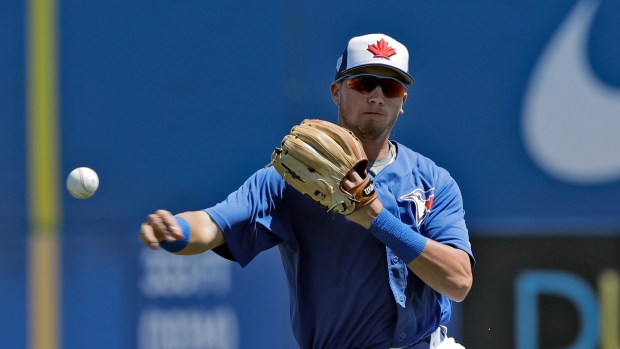
Now: Vladimir Guerrero Jr.
2022: Jordan Groshans
There’s no such thing as having too much talent, and defensive landing spots have a way of working themselves out.
There was a time when people wondered what the Houston Astros were going to do with a pair of young shortstops in Carlos Correa and Alex Bregman, while Boston Red Sox fans once saw prospect Mookie Betts blocked at second base by some guy named Dustin Pedroia.
Talent will find its way onto the field and the Blue Jays’ internal focus on up-the-middle position players means they can usually easily move down the defensive spectrum to a corner infield or outfield spot.
Currently dabbling at short and third, most believe Groshans will land permanently at the hot corner, where the skillset with both the bat and glove seem to be a perfect fit.
Missing most of the 2019 campaign with a foot injury didn’t help Groshans’ ETA, but he’s talented enough to catch up quickly and land in the majors in his age-22 year in 2022.
At that point, Martinez, who’ll be 20, could be right on his heels in the pipeline if the Dominican bonus baby continues to develop at the accelerated pace that scouts think he might.
SHORTSTOP
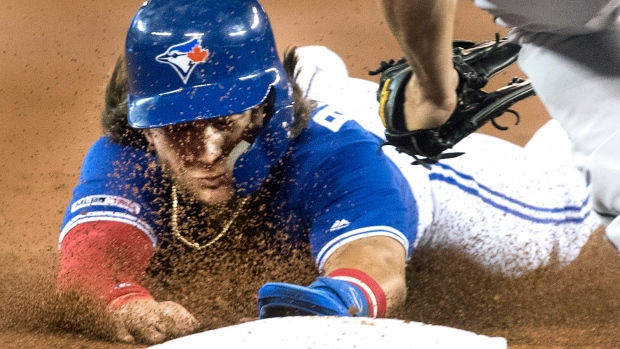
Now: Bo Bichette
2022: Bo Bichette
He’s far from a finished product at the most important position on the field, but Bichette’s progress over the last two years defensively has shown he’s willing to put the work in to get better and he did not look out of place in his 46-game debut.
A lot can happen in two years, but the only way Bichette is getting pushed off the position is if he regresses or the Jays have the chance to do something splashy and acquire a player like, say, Francisco Lindor.
Here’s betting Bichette is one of the most dynamic leadoff men in the game in two years, annually threatening the 30/30 mark.
LEFT FIELD
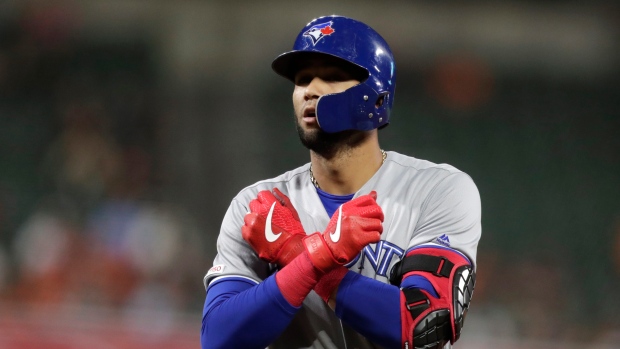
Now: Lourdes Gurriel Jr.
2022: Lourdes Gurriel Jr.
Another status quo position from the way things sit today, LGJ looked much more comfortable as an outfielder in 2019 than he did as an infielder.
But similar to his brother Yuli in Houston, it’s all about the bat.
Just now entering his prime at the age of 26, Gurriel could put up some impressive offensive numbers over the next couple of seasons if he can avoid the bumps, bruises and appendectomies that have piled up over his first two seasons.
If you take Gurriel’s first 149 games in the big leagues, he’s already produced an impressive .279/.320/.499 slash line with 31 homers. If he can reign in his free-swinging ways, there could be another level.
The seven-year, $22-million major-league deal he signed after defecting from Cuba runs out after the 2023 season.
CENTRE FIELD
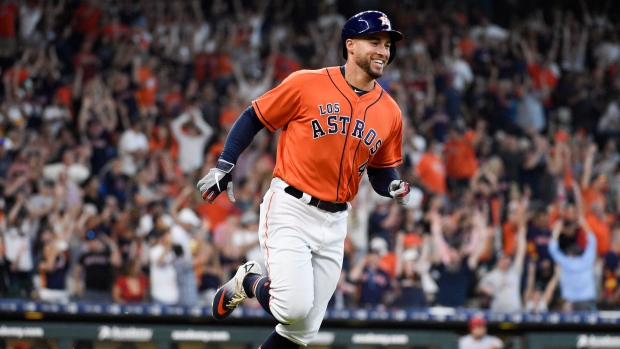
Now: Randal Grichuk
2022: George Springer
Unlike this exercise two years ago when it was tough to envision major splashes in free agency as the rebuild was just beginning, it’s much different this time around, and there are a couple of clear needs as well as potential targets.
Aside from pitching, which every team needs every single off-season, centre field is by far the biggest hole.
Enter George Springer.
While his value right now can be debated due to the sign-stealing exploits of his current employer, there’s no questioning Springer is exactly what seems to float the Jays’ boat.
Time and time again, they’ve targeted bats with big exit velocities — Kendrys Morales and Grichuk are two of the better examples — and players with raw skills who have maybe yet to put it all together.
Springer is the rare player with the tools who has put it all together, and he’s a free agent this winter.
Signing him to a five-year, $125-million deal this December — if Josh Donaldson got $92 million guaranteed over four years heading into his age-34 season, Springer is worth a good chunk more —would give the Jays Springer’s age-31-to-35 seasons and solve their centre field problem with a capable defender and a 35-homer bat to slide in behind Guerrero Jr.
RIGHT FIELD
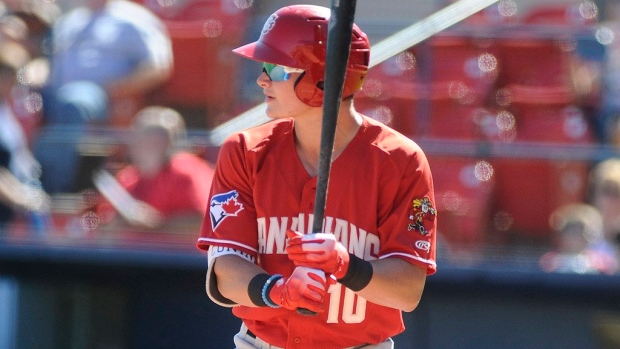
Now: Teoscar Hernandez
2022: Griffin Conine
While the majority of the infield either seems set or has internal options coming in the pipeline, the outfield is completely different, outside of Gurriel.
As of today, Grichuk and Hernandez are starters, with Derek Fisher, Anthony Alford and a host of other names trying to push their way into the picture.
A step forward in their late 20s for Hernandez, 27, or Grichuk, 28, could happen, but the one internal solution could be another bloodline player in Conine, son of Jeff, a 17-year big leaguer remembered most for his time with the Florida Marlins.
Drafted 52nd overall in 2018, Conine’s first full pro season in 2019 featured 125 strikeouts in just 80 games at Low-A Lansing, but the Duke product also crushed 22 homers in just 348 trips to the plate, finishing with an impressive .283/.371/.576 slash line.
Turning 23 this summer, Conine could be pushed aggressively if the approach improves as he hits the upper minors over the next year or so.
Not only would Conine be a solution in right field, he also adds a much-needed lefty bat to a right-handed heavy lineup.
Grichuk is signed through 2023, earning a base salary of about $9.3 million in 2022 and ’23, while Hernandez will enter arbitration next winter and is also scheduled to become a free agent following the 2023 campaign.
DH
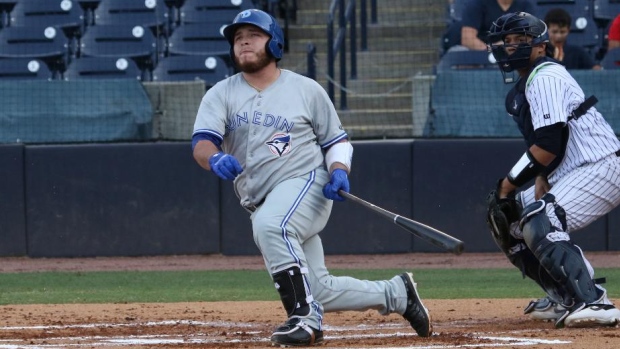
Now: Mix and match
2022: Alejandro Kirk
With most teams now reserving the title of full-time DH for elite, run-producing bats, it’s en vogue to use the spot as a chance to give veterans half-days of rest and cycle through enviable pitcher-hitter matchups.
The addition of the 26th roster spot for 2020 will allow teams to be more creative with their bench, and carrying three catchers could become more popular.
But that third catcher has to have a redeeming quality to be considered.
Kirk has that. He can simply hit. Everything.
His minor-league career batting average of .315 is impressive, as are the 89 walks to just 60 strikeouts, but the fact he put that advanced package on display this spring against major leaguers shows Kirk’s bat could probably hold its own against MLB pitching this season.
Catching 50 games per year and spending the rest raking as a DH built like a fire hydrant might be the best way to employ a player who’s already trending towards being a fan favourite from the day he arrives.
ROTATION
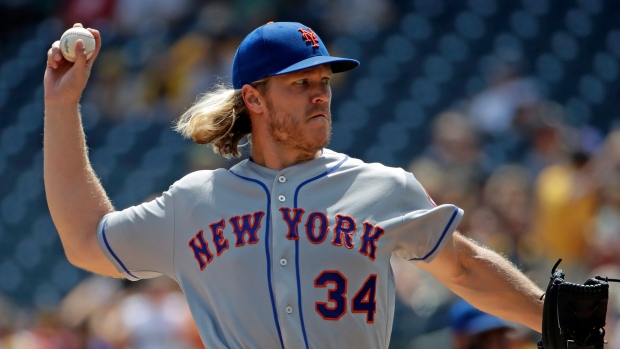
Now:
1—LHP Hyun-Jin Ryu
2—RHP Tanner Roark
3—RHP Matt Shoemaker
4—RHP Chase Anderson
5—RHP Trent Thornton
2022:
1—RHP Nate Pearson
2—RHP Noah Syndergaard
3—LHP Hyun-Jin Ryu
4—RHP Simeon Woods Richardson
5—RHP Alek Manoah
Atkins and the Jays started remaking their rotation this past winter, inking Hyun-Jin Ryu to a four-year, $80-million pact, which even surprised agent Scott Boras.
The 2022 campaign will be the third year of Ryu’s deal, but these days the 35-year-old lefty isn’t being counted on as the staff ace.
That torch was passed to Nate Pearson during the 2021 season, as the big right-hander took off in his first full trip through the majors.
With the Jays’ window now fully open after inking Springer in December of 2020, they brought back a familiar name ahead of the 2022 season, luring Noah Syndergaard back to the organization with a monster seven-year, $250-million contract.
Syndergaard, who missed all of 2020 after undergoing Tommy John surgery, returned midway through 2021 and looked as dominant as ever, convincing Atkins to push all his chips into the centre of the table and pair up Thor and Pearson atop the rotation.
In addition to Syndergaard, who the Jays drafted 38th overall in 2010, Clayton Kershaw, Justin Verlander, Zack Greinke and Max Scherzer are all slated to hit the open market at the end of the 2021 season.
Currently at about $98 million in payroll for the 2020 season, the additions of Springer and Syndergaard for $60 million per year total, plus inflation and minor additions elsewhere, the Jays will be back to running one of the top six or seven payrolls in baseball at around $175 million.
Woods Richardson, one of the arms acquired in exchange for Marcus Stroman, and Manoah, the Jays' first-round pick in 2019, being ready for opening day may be a bit of a stretch, but both could debut that summer if there aren't too many speed bumps over the next 24 months.
Closer
Now: RHP Ken Giles
2022: RHP Julian Merryweather
Bullpens are the most volatile unit in sports from year to year, so we won’t go through the futile effort of predicting what Jays manager Charlie Montoyo and pitching coach Pete Walker will have to work with in the late innings two years from now.
It’s likely Giles, a free agent at the end of 2020, will be used as a trade chip in the near future rather than be handed an extension, leaving the Jays trying to groom an affordable homegrown closer in order to mitigate rising costs elsewhere on the roster.
There are numerous candidates, but the sneaky bet is Julian Merryweather, the 2018 trade deadline return for Donaldson.
Currently still being developed as a starter, the right-hander’s fastball was creeping towards triple digits in shorter bursts and the rest of the arsenal might really fall into place once that move is permanent.
Jordan Romano, Trent Thornton, Sean Reid-Foley, Patrick Murphy and Hector Perez are a few other names to keep an eye on for high-leverage bullpen roles over the next couple of years.
2022 LINEUP
1. SS Bo Bichette, 24 (R)
2. 2B Cavan Biggio, 27 (L)
3. LF Lourdes Gurriel Jr., 28 (R)
4—1B Vladimir Guerrero Jr., 23 (R)
5—CF George Springer, 32 (R)
6—3B Jordan Groshans, 22 (R)
7—DH Alejandro Kirk, 23 (R)
8—RF Griffin Conine, 24 (L)
9—C Danny Jansen, 27 (R)
2022 TOP 10 PROSPECTS
1. SS/3B Orelvis Martinez
2. 2020 5th overall pick
3. C Gabriel Moreno
4. 2B/3B Miguel Hiraldo
5. RHP Adam Kloffenstein
6. RHP Kendall Williams
7. OF Dasan Brown
8. 2021 first-round pick
9. RHP Sem Robberse
10. RHP Eric Pardinho

